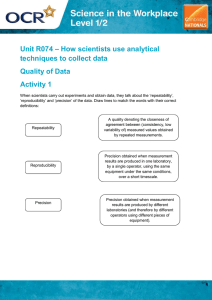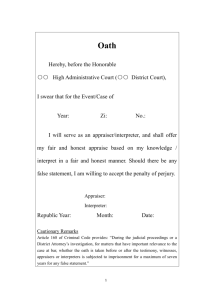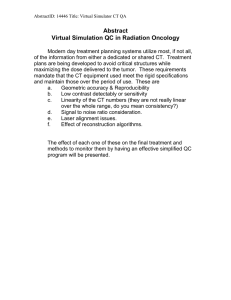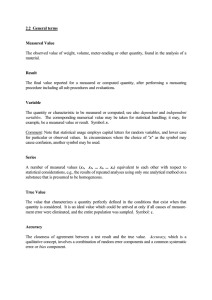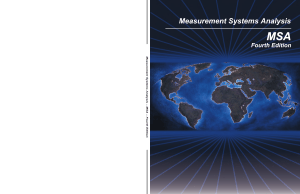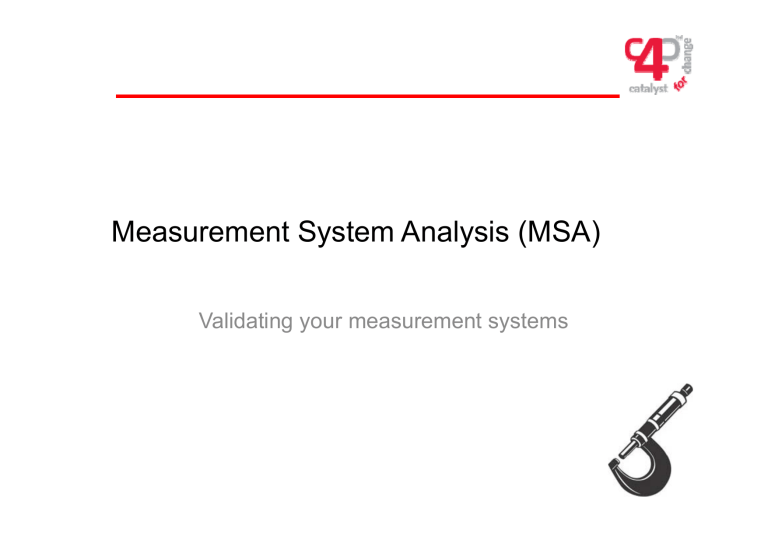
Measurement System Analysis (MSA) Validating g yyour measurement systems y Measurement Uncertainty LSL USL Measurement point pass or reject? • • Imagine you measure a component and find it to be at the point shown within the specification limits Would you pass or reject the component? Measurement Uncertainty LSL USL Measurement point pass or reject? • • You now discover that is has a measurement error associated with it as shown by the error bar above Would you pass or reject the component? Main sources of variation • • • • • Materials M th d Methods Machines People Environment Measurement System Analysis - MSA • A scientific and objective method of analysing the validity of a measurement system system. • A tool which quantifies – Equipment q p variation – Appraiser (operator) variation – The total variation of a measurement system • Examples E amples of meas measurement rement ssystems stems – – – – – – Micrometer Shadowgraph g p Go/no-go gage Data collection form S r e Survey On-time delivery report Variation Part Variability Measurement Variability Total Observed Variability Process A σ²Actual (Part) + σ²Meas. syst. = σ²Observed Total Process B Which process is best? Which is easier to improve? Components of Measurement Error 1. 2. 3. 4. 5. Resolution/Discrimination Accuracy (bias) Linearity Stability (consistency) Precision – Repeatability & Reproducibility 1. Resolution What is the length of this component to the nearest 10th? • • • Definition: D fi iti Th The capability bilit tto detect the smallest acceptable change C Cause: IInadequate d t measurement units Guideline “10 bucket rule” – Increments in the measurement system should be one tenth of the product specification or process variation • Actions: – Change measurement device – Record sample averages – Live with it but understand its limitations R Resolution l ti 1/10th 1 2 3 Poor resolution 4 1 2 3 Better resolution 4 What percent of requests are issued within 4 hours of receipt?? Customer Name Date Received Date Issued ________________ ________________ ________________ Poor resolution Customer Name Date Received Time Received Date Issued Time Issued ________________ ________________ ________________ ________________ ________________ Better resolution 2. Accuracy /Bias Master value Reference standard • • • Accuracy/Bias: A /Bi Difference Diff between the observed average value and the master reference Master value is an accepted, traceable reference standard Actions: – Calibrate regularly – Use operations instructions – Review R i specifications ifi ti ffor resolution – Validate data systems input accuracy – Create operational definitions X X X X X Less accurate Master value Reference standard X X X X X X X X X X More accurate X X X X X • • Measurement is M i ““true”” and/or d/ consistent across the range of the “gauge” Actions – – – – Check gauge specification Rebuild/replace gauge Use within restricted range Use correction factor Temperature deg C 3. Linearity Linear range Gauge reading deg C Form Linearity Super Outstanding Outstanding Incredible Excellent Great Very Good Good OK Fair Poor 10 9 8 7 6 5 4 3 2 1 4. Stability Time 1 Time 2 • • • Measurements remain M i constant and predictable over time i.e. accuracy remains constant No drifting, sudden shifts or cycles Actions – maintain and service equipment – use control charts – use SOP – ensure adequate training – regular audits Shift 5. Precision – Repeatability & Reproducibility Master value Reference standard • • Repeatability R t bilit - variation i ti th thatt occurs when repeated measurements are made of the same item under nder identical conditions Actions – repair, replace, adjust – SOP • • Reproducibility – variation that results when different conditions are used to make the same measurements Actions – training – SOP X X X X X X X X X X Poor precision Master value Reference standard XXXXXXX XXX Good precision Gauge R&R Studies • Method of assessing Repeatability & Reproducibility of a measurement system • A number of appraisers (usually two or three) measure a number of parts (or process output) (usually 5 to 20) a number of times (usually two or three) • The results are compared within each appraiser (Repeatability) and between appraisers (Reproducibility) • Randomisation is critical for repeat p measurements to avoid learning or copying. Gage R&R Study – Continuous Data Three appraisers, two measurements each % of Tolerance % of Total Variation EV=Equip’t Variation AV=Appraiser Variation PV=Part Variation R&R = √(EV²+AV²) Gage R&R Study – Attribute Data Two appraisers, two measurements each h Appraiser Variation Appraiser vs Control AV=Appraiser Variation AC=Appraiser vs Control R&R = √(AV*AC) Measurement Error Matching Exercise A. Time 1 Time 2 Shift B. 1. Resolution/Discrimination X X X X ( ) 2. Accuracyy (bias) X X X X X X 3. Linearity 4. Stability (consistency) C C. D D. XXXXXXX XXX 1 2 3 4 Tem mperature d deg C 5. Precision – Repeatability & Reproducibility E E. Gauge reading deg C
